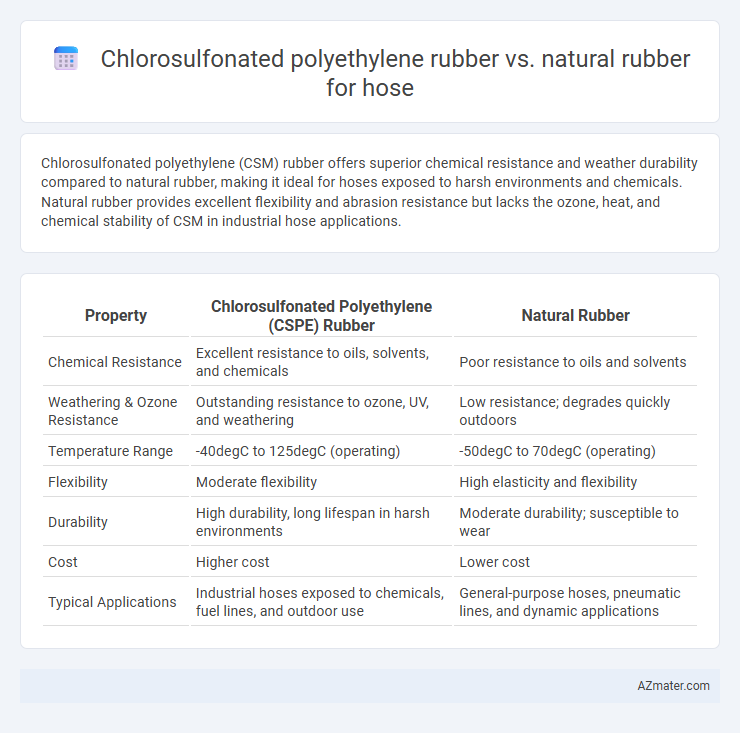Chlorosulfonated polyethylene (CSM) rubber offers superior chemical resistance and weather durability compared to natural rubber, making it ideal for hoses exposed to harsh environments and chemicals. Natural rubber provides excellent flexibility and abrasion resistance but lacks the ozone, heat, and chemical stability of CSM in industrial hose applications.
Table of Comparison
| Property | Chlorosulfonated Polyethylene (CSPE) Rubber | Natural Rubber |
|---|---|---|
| Chemical Resistance | Excellent resistance to oils, solvents, and chemicals | Poor resistance to oils and solvents |
| Weathering & Ozone Resistance | Outstanding resistance to ozone, UV, and weathering | Low resistance; degrades quickly outdoors |
| Temperature Range | -40degC to 125degC (operating) | -50degC to 70degC (operating) |
| Flexibility | Moderate flexibility | High elasticity and flexibility |
| Durability | High durability, long lifespan in harsh environments | Moderate durability; susceptible to wear |
| Cost | Higher cost | Lower cost |
| Typical Applications | Industrial hoses exposed to chemicals, fuel lines, and outdoor use | General-purpose hoses, pneumatic lines, and dynamic applications |
Introduction to Chlorosulfonated Polyethylene Rubber and Natural Rubber
Chlorosulfonated polyethylene (CSM) rubber is a synthetic elastomer known for its excellent resistance to chemicals, ozone, weathering, and abrasion, making it ideal for demanding hose applications exposed to harsh environments. Natural rubber, derived from latex sap of the Hevea brasiliensis tree, offers superior elasticity, tensile strength, and resilience, which are critical for flexible and high-pressure hose performance. While CSM excels in durability against oils, solvents, and extreme weather, natural rubber provides enhanced flexibility and mechanical properties suitable for general-purpose hoses.
Chemical Structure and Composition Comparison
Chlorosulfonated polyethylene (CSPE) rubber features a backbone of polyethylene with chlorosulfonyl functional groups, providing high chemical resistance and weatherability, whereas natural rubber consists primarily of cis-1,4-polyisoprene, a hydrocarbon polymer with unsaturated double bonds. The incorporation of chlorine and sulfonyl groups in CSPE enhances its resistance to ozone, UV radiation, oils, and chemicals, making it suitable for harsh environments. Natural rubber's unsaturated structure offers excellent elasticity and tensile strength but is more vulnerable to oxidative degradation and chemical attack compared to the chlorosulfonated polymer matrix of CSPE.
Physical Properties: Strength, Flexibility, and Durability
Chlorosulfonated polyethylene (CSM) rubber exhibits superior strength and chemical resistance compared to natural rubber, making it ideal for hose applications exposed to harsh environments. CSM offers enhanced flexibility over a wide temperature range and maintains its physical integrity under prolonged stress, outperforming natural rubber in durability. While natural rubber excels in elasticity and tensile strength, CSM's resistance to ozone, weathering, and oils ensures longer hose service life and reliability in industrial settings.
Resistance to Weathering and Ozone Exposure
Chlorosulfonated polyethylene (CSM) rubber exhibits superior resistance to weathering and ozone exposure compared to natural rubber, making it ideal for hose applications in harsh environmental conditions. The chemical structure of CSM prevents degradation caused by ultraviolet rays, ozone, and oxidative agents, ensuring long-lasting durability and flexibility. In contrast, natural rubber is more prone to cracking and brittleness when exposed to ozone and prolonged outdoor weathering.
Performance in Extreme Temperatures
Chlorosulfonated polyethylene (CSPE) rubber offers superior resistance to extreme temperatures, maintaining flexibility and durability in a broad range from -40degC to 120degC, outperforming natural rubber which typically degrades or hardens beyond 70degC. CSPE's enhanced thermal stability and resistance to ozone and UV exposure make it ideal for hoses operating in harsh environmental conditions. Natural rubber hoses may fail faster under extreme heat or cold, limiting their use in demanding industrial or outdoor applications.
Chemical and Oil Resistance Capabilities
Chlorosulfonated polyethylene (CSPE) rubber exhibits superior chemical and oil resistance compared to natural rubber, making it ideal for hoses exposed to harsh environments and aggressive chemicals. CSPE maintains its integrity against a wide range of solvents, fuels, and oils, whereas natural rubber tends to degrade when in contact with petroleum-based fluids, causing swelling and loss of mechanical properties. This enhanced resistance in CSPE hoses ensures extended service life and reliability in industrial and automotive applications where chemical exposure is frequent.
Lifespan and Maintenance Requirements
Chlorosulfonated polyethylene (CSM) rubber offers superior resistance to weathering, ozone, and chemicals, resulting in a significantly longer lifespan compared to natural rubber when used in hoses. Natural rubber tends to degrade faster under UV exposure and harsh environmental conditions, increasing the frequency of maintenance and replacement. Consequently, hoses made from CSM require less frequent maintenance, reducing downtime and associated operational costs.
Cost-Effectiveness and Economic Considerations
Chlorosulfonated polyethylene (CSPE) rubber offers superior resistance to weathering, chemicals, and ozone, resulting in longer hose lifespan and reduced maintenance costs compared to natural rubber. Although the initial cost of CSPE hoses is higher, their durability and performance reduce total cost of ownership, making them more cost-effective for demanding industrial applications. Natural rubber hoses, while cheaper upfront, often incur higher replacement frequency and maintenance expenses, driving up long-term economic costs.
Typical Applications in Hose Manufacturing
Chlorosulfonated polyethylene (CSM) rubber is favored in hose manufacturing for its exceptional resistance to chemicals, ozone, and weathering, making it ideal for industrial hoses exposed to harsh environments such as chemical transfer and fuel delivery. Natural rubber is commonly used in hoses requiring excellent flexibility, abrasion resistance, and tensile strength, suitable for applications like air and water hoses in construction and agriculture. The selection between CSM and natural rubber depends on the specific operational demands, with CSM offering superior durability in corrosive conditions and natural rubber providing cost-effective performance in less aggressive settings.
Selecting the Right Rubber Material for Hoses
Chlorosulfonated polyethylene (CSM) rubber offers superior chemical resistance, ozone durability, and weather resistance, making it ideal for hoses exposed to harsh industrial chemicals and outdoor conditions. Natural rubber provides excellent flexibility, abrasion resistance, and tensile strength, suited for applications requiring high elasticity and mechanical stress absorption. Selecting the right rubber material for hoses depends on the operational environment, with CSM preferred for chemical exposure and harsh climates, while natural rubber excels in dynamic, wear-intensive applications.

Infographic: Chlorosulfonated polyethylene rubber vs Natural rubber for Hose
 azmater.com
azmater.com